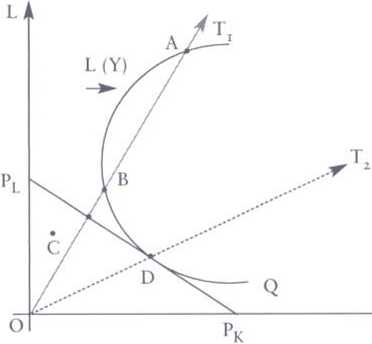Review of Islamic Economics, Vol. 8, No. 2.,∙ z004
Figure ɪ: Input-oriented Technical and Allocative Efficiency

Efficiency
Measures
TE=OBZOA
CE=OCZOA
AE=CEZTE
=OCZOB

If we know the ratio of input prices i.e. the slope of the P[P%
isocost in Figure 1, we can get the allocative efficiency (AE) of a PU
operating at A defined as AE = OC / OB. Now, if we take the product
of efficient quantity and input price ratios, we can get a measure of
overall or economic efficiency (OE) as under. Notice that OE equals
cost efficiency CE and is the same as economic efficiency EE. The
terms EE, OE and CE are interchangeably used in the literature
under review. Thus,
EE = OE = (TE). (AE) = (OBfOA). (OCfOB)
that reduces OCfOA = CE
As (a) CE = OC / OA is less than one, so (b) the gap ∣1 - (OC I
OA)] measures overall cost inefficiency CIE.5 This can vanish if
technological improvement leads over time the PU to produce at point
D, input prices remaining unchanged.
The above explanation of the conceptual framework for
efficiency measurement is provided in terms of the cost criterion. Even
though it implies profit maximization, a number of studies target
profit directly as the focus of their attention. Both cost and profit
criteria are used to study the impact on them of a host of identifiable
factors ownership forms, scale of operations, nature of the economy,
state of competition, business environment and the like via the
efficiency route. The approaches may well differ in each case.
More intriguing information
1. Measuring and Testing Advertising-Induced Rotation in the Demand Curve2. The name is absent
3. Equity Markets and Economic Development: What Do We Know
4. The name is absent
5. AJAE Appendix: Willingness to Pay Versus Expected Consumption Value in Vickrey Auctions for New Experience Goods
6. The name is absent
7. Towards Teaching a Robot to Count Objects
8. The geography of collaborative knowledge production: entropy techniques and results for the European Union
9. Tax Increment Financing for Optimal Open Space Preservation: an Economic Inquiry
10. The name is absent